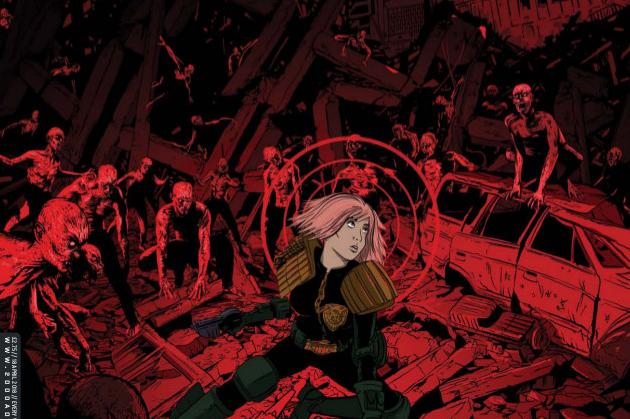2000AD, PROG 2077 REVIEW
Writers: TC Eglington; Gordon Rennie; Dan Abnett; Emma Beebie; John Wagner(w) Staz Johnson (a) Abigail Bulmer (c) Annie Parkhouse (l)
Artist: Staz Johnson; Simon Coleby; Steve Yeowell; Mike Collins; Cliff Robinson; carlos Ezquerra
Colourists: Len O'Grady; John Charles; Jose Villarrubia
Letterers: Ellie De Ville, Annie Parkhouse; Simon Bowland
The Sons of Booth continue to stir up discontent for their own political ends in Judge Dredd: Flaws. TC Eglington’s script perfectly satirises the behaviour of the far right individuals who exhibit a desperate need for leadership, and the media’s willingness to provide a platform to people who openly threaten the validity of the media. Opening with an angry protestor who might just be a parody of a particular 2000AD youtube reviewer (or it might just be that the angry men in red caps are in vogue at the moment), Flaws is a police procedural at heart, with Dredd doing some honest to goodness police work, tracking down some missing machinery linked to the extremist group. Not long ago, Dredd stories involved radical pro-democracy groups, turning to violence to overthrow the fascist judges. As elements of the real world lose their taste for democracy, the target of 2000AD's social commentary shifts, settings it's sights firmly on the rise of populism and authoritarianism disguised as democracy. This is a considered and slow paced piece, but when action does come its very well handled. Artist Staz Johnson gives up a particularly grubby Mega city One, with heaving crowds and a raft of memorable individual characters.
Having efficiently kidnapped a high ranking Souther, Kapiten Atalia and her squad are on the run, heading back to Nort territory with their enemy in pursuit. Jaegir: In The Realm Of Pyrrhus comments on the cold calculation on war, where life and death are decided by algorithms. Amid the non stop battlefield action, there time for some character development, as small details of Atalia’s past, and Nord society, are revealed.
Sinister and Dexter are also on the run from “The Devil”, whichthey;ve discovered might not just be a cool hitman name. Sinister Dexter: The Devil Don’t Care has a fast moving script, packed with action and humour, wonderfully conveyed by artist Steve Yeowell whose characters are in a constant state of movement. Shoot outs, comedy and foul mouthed car chases are packed in to five pages as characters are thrown together, desperately fleeing their unstoppable foe.
Art duties on Anderson PSI Division: Undertow shifts from David Road to Mike Collins and Cliff Robinson, with Joe Villarubia continuing on colours. It's just the latest shift in the story, which crams lots of ideas into not much space. With four PSI Judges on a case, much of the dialogue is in coloured, stalk-less balloons, making it difficult to attribute dialgue to specific characters. Pair this with the return of the possessed Judge Karyn, whose troubled past may be mystery behind the scenes but is given limited explaination for newer readers, and Judge Echo whose unusual situation has a massive impact on how the story is conveyed. Monsters appear with no explanation, and behind it all ther's an as yet unexplained conspiracy, The sudden appearance last Prog of a character who closely resembled Al Ewing’s Judge Tempest is revealed to not be Tempest, but yet another unknown, who is again given little backstory or clear purpose. Undertow is a confusing blast of action, difficult to keep up with and heading in an unknown direction.
An injured Johnny Alpha hallucinates a visit from old friend Wulf Sternhammer, who provides moral advice in the way that only fictional hallucinations can, in Strontium Dog: The Son. Having teamed up with Wulf’s son Kenton, Alpha has been doing his very best to convince Sterhammer Junior that the bounty hunting game isn’t the right career move. The heartfelt and tender conversation between Johnny and Wulf provides nostalgic moment in which we can appreciate just how good Strontium Dog used to be, back before Johnny became quite as emotionally damaged as he is now. Does this mark a turning point for the character, and a return to the carefree days of old? Or, is writer John Wagner setting us up for yet anotherdevasting loss?





